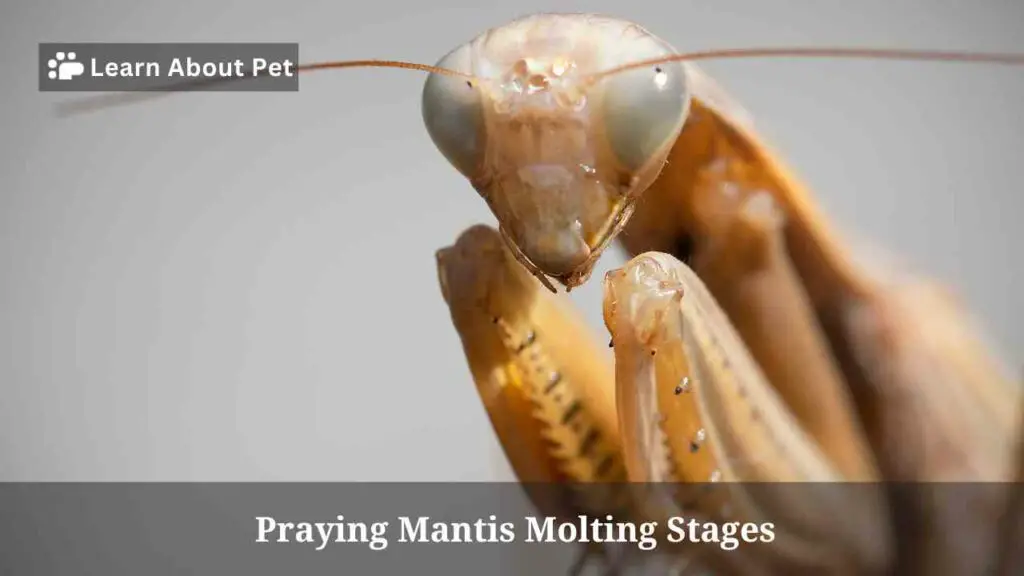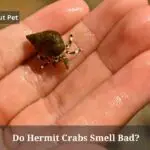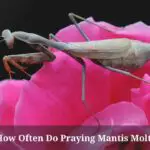Praying mantis are pet arthropods that require a molt process to grow. Mantis have a rigid and inflexible exoskeleton and cannot grow with their exoskeleton because it prevents them from growing bigger. In order to increase in size, mantis need to break out of their old exoskeleton and slowly form a larger one.
The praying mantis will molt several times throughout its life. This time, we will tell you about the praying mantis molting stages and how we can help our pets.
The praying mantis molting stages depend on sex and specific species. Most praying mantis species will molt between 6-10 times. L1 is the newborn mantis nymph. After the second molt, the mantis becomes L2. When praying mantis molts again, it goes into L3, and so on until L6-L10 in their lifetime.

For praying mantis owners who have never known about the mantis molting process, read this article to make it easier to prepare anything when your pet grows.
How Do You Know When A Praying Mantis Is Going To Molt?
First, let’s get to know about praying mantis molting signs. The table below will make it easier for you to know several indicative signs when molt will occur in mantises.
| Mantis molt indicative signs | Explanation |
| Refusal of food | The premolt will make the mantis enter the fasting phase for a few days. Mantis can not eat for up to weeks until the molt is complete. |
| Inflated abdomen | Praying mantis will absorb a large amount of water in the premolt stage until they finally molt. |
| Hanging upside down | Hanging upside down will make it easier for mantis to shed their old skin. Mantis will still hang upside down in another spot for the hardening process. |
| Swollen wing buds | Sub-adult mantis will show swollen wing-buds as a sign that their body will grow beyond their exoskeleton. |
| Erratic movements & vibrations | Mantis will perform frequent vibrations and erratic movements. This incident will repeat itself until they molt. |
Most praying mantises will show some of the signs above and ensure you never intervene in any pre-molt or molting process.
How Long Does A Praying Mantis Take To Molt?
Mantis can take 9-15 days between molts. It depends on the temperature and humidity. First, praying mantis will release their exoskeleton and hang back behind it. The mantis molting position is upside down to make it easier for them to shed their old skin.
Mantis will step back a little to move away from the old skin. Mantis will enter the hanging phase for hardening or fortifying their new exoskeleton. In this phase, the mantis body is soft and vulnerable.
New praying mantis owners are sometimes confused about praying mantis molting or dying, because they have never seen their pet in that condition before. The mantis body condition will look normal if the molt process is successful.
Praying Mantis Molting Stages – How Long Does It Take?
You might expect 9-15 days for a mantis molt. Praying mantis molting stages pictures will show the difference in their sizes from L1 to L10 because every time a mantis molts, they will grow a new exoskeleton that adapts to their body growth.
There are several factors that can cause mantises to fail to molt or mismolt because they cannot remove their old exoskeleton, and it gets stuck in their body.
If mantises are too dry, have insufficient space, or are dehydrated, they will have difficulty removing their outer layer and cause mismolt. Humidity and sufficient water in the praying mantis body are the main factors for the success of the mantis to molt.
Please be careful to care for the mantis before they enter the molt process by providing enough food, enough space for the mantis to hang, and the right temperature.
A single mismolt can cause a mantis to experience physical deformities such as a twisted leg, splayed wings, bent body parts, and lead to death.
How Long Should I Wait To Feed My Mantis After Molt?
Wait until the mantis has a hardened exoskeleton, and you can feed the mantis about 2-4 days after the molt process is complete. Most mantis will take the food for more than 24 hours after molting, because they have finished their fasting phase during molting.
The vulnerable body condition of the mantis can be disturbed by them and create the possibility of mismolting. Don’t put any prey inside the cage when the mantis is molting.
Any insects can disrupt the mantis molt process and cause fatal conditions such as mismolt. Don’t have any insects in the environment from the premolt until the molt is over.
It will be hard to notice for new praying mantis owners who see their pet molting for the first time. Learn about praying mantis molting stages and having experienced it several times.
Mantis need time to rest before they are ready to eat again. Give food gradually until the mantis looks okay to carry out usual activities.
Can A Praying Mantis Molt On The Ground?
There is not a single record of mantis molting on the ground. See the praying mantis molting stages video to ensure mantis will do the upside down position every time they have a molt process. There is no difference when the mantis molts from L1 to L10.
Mantis will do an upside down to release their old exoskeleton, and move a little bit for the hardening phase.
Mantis will step on their old exoskeleton slowly until their body comes out. This condition will pass completely when their position is upside down and will not occur when the mantis molts on the ground.
How Long Do Mantis Live After Final Molt?
Praying mantis will only live a few weeks after the final molt. You can expect a mantis to live between L6-L8, although there are still rare cases for pet owners having a mantis that lives up to L10.
The lifespan of mantis is varied. The larger species can live 4-6 months, while the smaller species may live only 4-8 weeks.
Whether or not a mantis can live until the final molt depends on how you care for your pet, and the most crucial things in mantis life are humidity and hydration. If you can meet the right temperature for your pet, mantis can live long enough according to their life span.
Do Praying Mantis Eat Their Molted Skin?
Praying mantis do not eat their molted skin because they prefer eating live prey. But praying mantis will be hungry after the molting process. If there’s no food around them, mantis can munch a little from their molted skin.
It’s not uncommon to see a mantis take their little molted skin to eat it, but no one has seen a mantis eat it all.
If the mantis have come down from their upside down position, you can start feeding them. Ensure the mantis has a complete body without any physical deformities. The mantis molted skin will fall to the ground or disappear overtime.
Final Verdict
The praying mantis molting stages vary depending on the species and are called L1-L10 depending on how much the mantis will molt through their lifetime. Praying mantis requires a molt process due to growing and shedding their old exoskeleton to harden the new one.
Recognize mantis molting signs, and fulfill mantis needs such as humidity, food, enough space, and prevent mantis from dehydration. The praying mantis molting time is 9-15 days.
Mantises who are successful in their molt process will look normal and carry out their activities as usual.

Welcome to Learn About Pet. My name is Rajkumar Ravichandran and I love all pets, travel, and amazing food. I write about my passion and personal experience caring for multiple pets in this blog! ❤️
Post Disclaimer
DISCLAIMER: THIS BLOG OR WEBSITE, "Learn About Pet", DOES NOT PROVIDE YOU WITH MEDICAL ADVICE AND IS NOT A SUBSTITUTE FOR MEDICAL ADVICE. ALWAYS GET IN TOUCH WITH YOUR PERSONAL VETERINARIAN AND USE INFORMATION HERE AS GENERAL ADVICE.
The information, including but not limited to, text, graphics, images and other material contained on this website are for informational purposes only. No material on this site is intended to be a substitute for professional veterinary advice, food recommendation, diagnosis, or treatment. Always seek the advice of your veterinarian or other qualified health care provider with any questions you may have regarding a medical condition or for pet food related questions.







